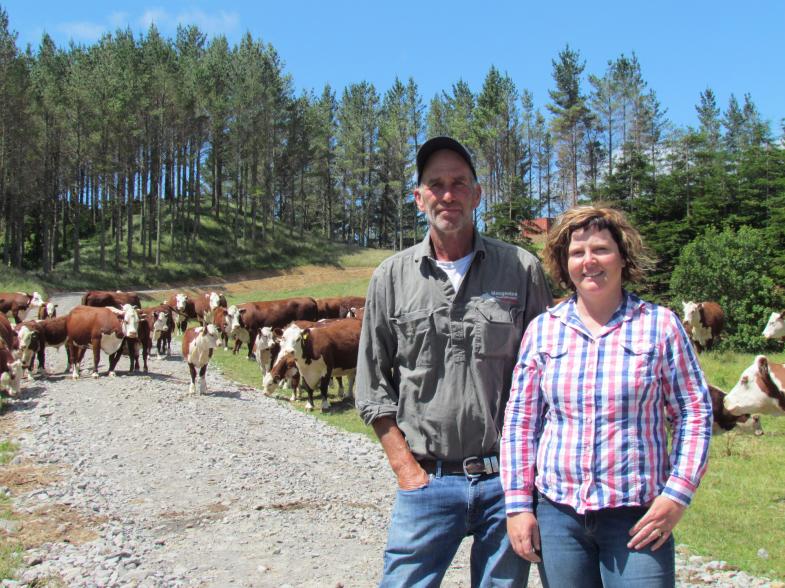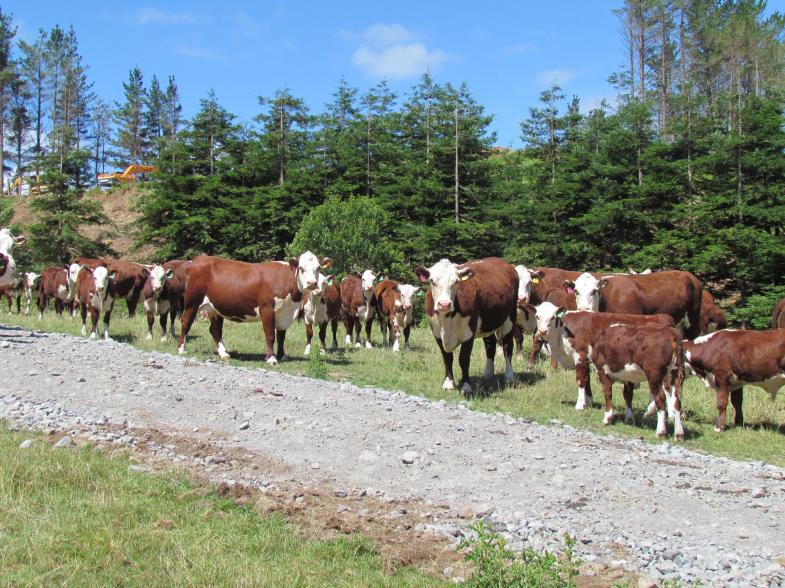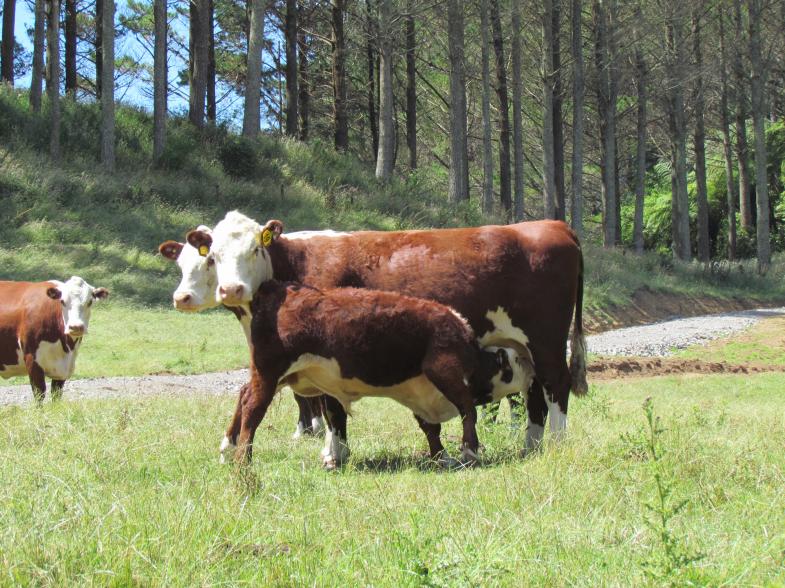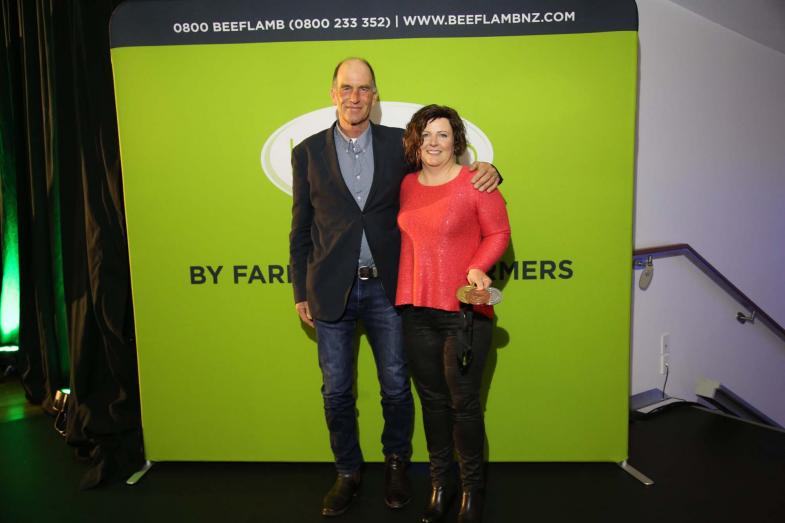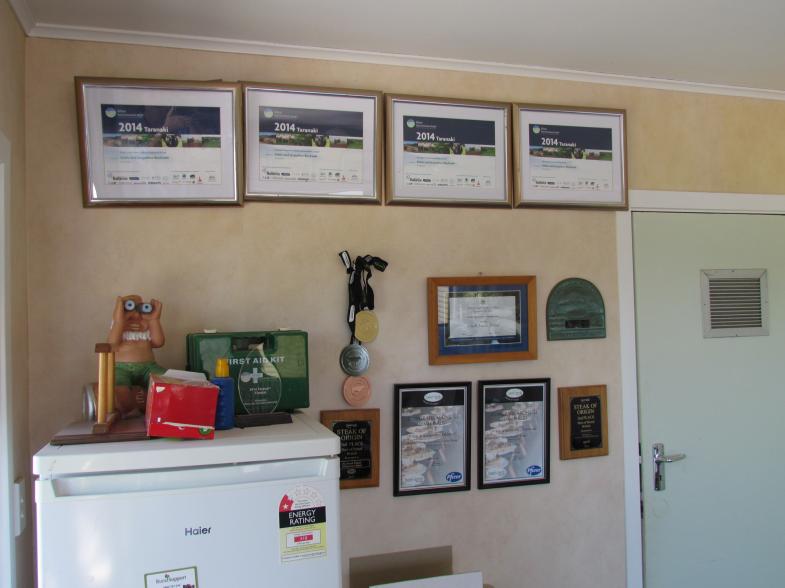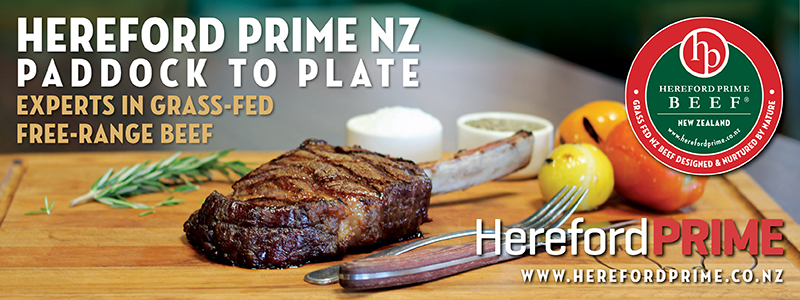 |
|
|

Naught to 100 – the rise of Mangaotea HerefordsWords / Photographs by Natalie Campbell
Being surrounded by dairy farmers means the priorities in the breeding programme for Jacqueline and Robin Blackwell of Mangaotea Herefords varies slightly from what most would consider traditional. Dairy farming clients expect good clean markings and cosmetics in their bulls and that’s an area the Blackwells are expected to place emphasis on when offering bulls for sale. It’s a delicate balancing act they manage without compromising on quality, while offering bulls with a moderate EBV package and structural soundness. The couple’s enterprise focuses on bull breeding and dairy support and winters 8500 stock units. It’s a multi-faceted enterprise that includes a Hereford stud, Angus stud, Murray Grey stud, Southdown stud, dairy heifer and cow grazing, supplement feed sale, Jersey bulls and a commercial Romney flock. The property is 560 hectares (effective), and annual rainfall averages just over 200mm. The farm sits between 200 and 300 metres above sea level. Being in the heart of dairy country, near Inglewood in Taranaki, the Blackwells have forged a niche market catering to the needs of their surrounding dairy farming neighbours. The Hereford herd has been Jacqueline’s passion since she founded it in 2002. She had been working off farm, was looking to make an on-farm investment, and Herefords appealed. She started out with small numbers and had the goal to reach 100 registered cows – a target she has now achieved. It was a few years ago, after husband Robin could see how much fun she was having, that he established a registered Angus herd. Jacqueline was brought up in nearby Ratapiko, the daughter of a dairy farmer, and readily admits she never had any interest in milking cows. She really enjoyed working with animals and outdoors, but was adamant she was never going to be putting cups on. Following a career off farm and after meeting Robin, she has returned to the land and has found her place in dry stock farming. The opportunity arose to lease 179ha at the back of the home farm and Jacqueline secured that lease. She has been managing that in conjunction with 40ha of the home farm for the past 10 years. She gets a lot of satisfaction out of growing out the animals and seeing them reach their genetic potential and would like to incorporate a finishing platform and carry through the females that don’t make it as herd replacements. “It’s about building the brand and adding value, but it will need to be cost competitive with dairy grazing,” she says. Weaning and pregnancy testing in Jacqueline’s Hereford herd occurs at the same time in late February or early March – as the season allows. Pregnancy testing is the first benchmark for the females that are retained in the herd. Any dry female is culled. The target weaning weight for the heifer calves is 240kg live weight. “We look at the mature cow weight of the dam in relation to the weaning weight; 50% or more of the cow body weight at weaning time is the target.” Single sire mating has traditionally been used, with bulls joining the cows on October 10 for a July calving. The aim is an eight-week calving window. However, a bull breakdown last season means they have been multi-sire mating, so parent verification by DNA testing will be implemented. Matariki genetics are having a big influence currently and Grassmere and Okawa sires have also had a role in the development of the herd. Jacqueline says they sourced some semen straws of Matariki Holy Smoke last year. Twenty-nine straws were used and 20 held, so she is excited about those calves on the ground now. Matariki D493 has also been used in the past. Due to soil type, which ranges from peat swamp to volcanic ash, which is nice and fertile but needs respecting, the heavier cattle are moved off the hills in winter to minimise damage. “Before winter we bring the heavier stock down onto the flats and winter them on the easy country,” Robin says. The cows are break fed and calved behind a wire on conserved pasture. All calves are weighed at birth using a small crate and adjusted sheep weigh bar, and Jacqueline says the quiet nature of the breed means she feels safe while undertaking this job. Jacqueline says they pride themselves on the temperament of their herd, which they feel is another vital characteristic for their dairy clients. The cows and calves are shed out onto more conserved pasture before they go back on to the hills once the calves are a couple of weeks old, and there the cows and calves rotate the hill country and are fed hay as needed. Animal health inputs are kept to a minimum in the mixed age cows, which are treated with a Genesis Ultra once a year. The calves are treated with a 10 in 1, BVD and leptospirosis vaccination at weaning time. This year they asked Bill and Judy Austin to scan their replacement heifers, which alongside the DNA testing will help build up more data for the herd and provide more information for selecting herd replacements. They scanned for EMA and IMF so they can build a picture in relation to the retail beef yield EBV. Replacement heifers are selected for a clean head, white shoulder, good markings, structural soundness, good feet and a moderate EBV package. The selection process for herd replacements is a balancing act around the aesthetics of the animal, structural soundness and a moderate EBV package. Moderate birth weights, growth rates, good milk figures, and fertility are all part of the EBV package Jacqueline is targeting in a moderate-sized female herd, and if a female fails to conceive, there are no second chances. There are similar criteria for bull selection for use in the Hereford herd, focusing on calving ease and a moderate birth weight EBV. They also must look the part. “We need to think about the calving experience for our clients; will it be easy calving and have good growth rates?” Jacqueline says. The needs of their clients are at the forefront of the Blackwells’ minds and to help them do this, they also breed Angus and Murray Grey bulls and buy in weaner Jersey bulls, which they grow out and offer at their annual on farm sale.
On farm auctionAt the annual on farm Mangaotea bull sale in September, the Blackwells offer 180 bulls. A third are Jersey bulls and the remainder made up of Hereford, Murray Grey and Angus bulls. The Jersey bulls are purebred and sourced directly from three farmers, which allows the Blackwells to confidently share the traceability story of all the cattle they put up. They say the homebred and self-sourced bulls command a premium, which their clients also benefit from when they have finished using the bulls – either via the works or by on-selling them back into the market, and from selling the dairy beef calves and weaners from these bulls. “We started that a couple of years ago and the transparency is vital.” The Jersey bulls are sourced from both purebred performance recorded and registered herds, and the couple specify the farm of origin in the sale catalogue. Their first on-farm sale was 22 years ago, and they offered 50 bulls, of nearly all Jersey genetics with a handful of Hereford and Angus, but they found it harder and harder to source good Hereford bulls to offer. It was also at this time that Jacqueline was looking for an investment and Herefords appealed to her for their temperament and their red factor. “We are aware of what we sell, and it has to be quality, not just numbers,” she says. Jacqueline bought her first cows in 2002 and had her first calves on the ground in 2004, and has steadily built numbers up. In 2006 Robin purchased his first Angus cows.
“We have 200 registered cows all-up between the three breeds,” Jacqueline says. Robin’s daughter Zarrah has returned home and the Jerseys and Murray Greys are now her responsibility, and it’s likely management of the Angus herd will soon be passed to her too. Zarrah has worked on large cattle stations in Australia for the past four years, and has gained experience on properties in and around Taihape. She also spent time as a stock agent for CRT in the South Island. The Hereford bulls offered at auction are chosen for their quiet temperament, cosmetics, and structural soundness backed up with balanced EBVs. The Blackwells’ dairy farming clients also demand their bulls are well grown, especially clients with Holstein Friesian herds. Their selection criteria are hitting the mark, with some clients repeat purchasers since the first sale 22 years ago. The Blackwells not only host their own auction of genetics, but they also host a charity auction following the bull sale. They choose a different charity each year and gather donated goods, which are put up for sale. Last year’s chosen organisation was the Rural Support Trust and in an hour the auctioned goods raised a whopping $13,000. “We have done this for the past 10 years and past organisations to receive funds from the charity auction have included schools attended by clients’ children, Cancer Society and the Taranaki Rescue Helicopter,” Jacqueline says. Jacqueline says the three registered beef herds are a big job in terms of admin work, but their desire to offer their clients certainty and traceability is their motivation. “Any performance recording we can do helps show we are delivering a really good product,” she says. “We are here to help our beef and dairy clients add value to their business.”
Dairy supportRunning alongside the three beef herds are 950 dairy heifers that are grazed from May to May. The heifers are grazed for a weekly rate and Robin says they have had many of the same clients for years. They also supply the bulls to run with the dairy heifers. Another income stream generated by dairy support is the sale of 600 to 700 round hay bales annually. This has typically been surplus to the Blackwells’ needs, but supply will be tight this coming year as they need to replenish their own stocks after a difficult winter. Along with the dairy heifers, they also winter about 300 dairy cows. Robin says that when running other people’s livestock, your own animals tend to come second in the hierarchy, which acts as built in selection pressure. They also farm Jersey bull calves and, while they can be a challenge as weaners, Robin says they run them because their clients like them for use over their heifers. The Jerseys are bought in as 90kgLW weaners in December, with the bulk of those weaners being sired by identified bulls. The Blackwells farm them through. The top 30 from a mob of about 80 are selected and sold as yearlings in their September auction and the rest are used on farm over the dairy heifers and carried through and sold as two-year-olds. They have good success with the Jersey bulls over the dairy heifers, recording an empty rate of about 3%. Looking to the future, Jacqueline says they want to continue lifting the quality bar. For her that means looking to lift weaning weights and improve on the animal package they already offer. Another aspect to consider is adjusting farm policies so the farm can react more quickly to the extremes that have been experienced the past couple of years. She says it has been a long journey from 2002 to now, having reached her goal of 100 registered cows, but she’s also looking at the possibility of incorporating a finishing platform within the business. They felt a few more ‘opportunities’ were needed in the system and a finishing platform could be one option, as it adds value and removes some of the intensity of the operation. It would also make their business less vulnerable to the dairy payout and spread some risk. The multi-layer business is run by Robin and Jacqueline, who have recently been joined by Zarrah, and they also employ a stockman general, Mike Ussher. Mike is a former dairy farmer and has also been a show shearer, and he’s been with the Blackwells for four years. Robin also has two sons who, while they don’t work on the farm, are still interested in what happens. Daniel is a computer programmer based in London and Hamish and his wife Sally live in Awatere Valley, where they own and run a contracting business, developing the infrastructure for vineyards, along with managing their own 35ha of planted vines, the fruit of which they sell to wineries.
Sheep support cattleComplementing the cattle is a mob of 700 mixed-age Romney ewes, which are run with a Southdown sire and all progeny is finished. Robin says the cross-bred progeny finish well and flock replacements have been bought in from the past three years from the same farmer in Aria. The Romney ewes lamb on average 150%, and he admits they are the ‘poor cousins’ to the cattle classes in the business. Drafting of the lambs begins in November, with the last of the lambs sold in February at an average of 17.5kgCW. The small Southdown registered stud of 50 ewes means they breed enough quality rams to use over their own Romney flock and sell about 20 rams to clients in the lower North Island. Robin likes the Southdowns because they are early maturing, have good growth rates and they “weigh like lead”. The Southdown ewes run with the commercial Romneys, except for at mating and lambing.
Industry accoladesThe Blackwells have been recognised by their peers and industry leaders for how they farm. A big win, and the first time it’s ever occurred, was taking out all three places in the Hereford class in the annual Steak of Origin (SOO) competition in 2017. Jacqueline recalls feeling shocked and overwhelmed at the time. “When they were reading out the category award and they said it was the first time in history someone had taken out all three places, I then realised it was me. I was in shock,” she recalls. It’s the scientific side of farming and competitions like the Steak of Origin that appeal to the Blackwells. The couple say it’s a matter of putting themselves out there and it’s good benchmarking for their breeding programme. “It’s really good to have a breed class now and benchmark [directly] against the breed,” Jacqueline says. She had entered the SOO previously, but hadn’t had much success, however Robin had had more luck with Angus entries. The clean sweep at SOO last year is not the only accolade of note the Blackwells have received. They were early adopters of the Taranaki Regional Council’s farm plan, which means they have been fencing off waterways since 1991 and 90% of the main farm waterways have been fenced off. They have also planted more than 10,000 trees and there are two fenced 1.5ha blocks of QEII covenants on the property. In 2014 they entered the inaugural Ballance Farm Environment Awards in Taranaki and were placed second overall – winning four of the eight awards on offer that year. The couple say they got good feedback from the judges which was very constructive, and the atmosphere very positive. The categories they won awards for were; The Beef and Lamb NZ Livestock Award, Taranaki Regional Council Sustainability Award, Donaghys Farm Stewardship Award, and the Hill Laboratories Harvest Award. They have also won the Taranaki Meat and Fibre Farmer of the Year, Taranaki Regional Council Environmental Award. They have started attending NZ Hereford Association herd tours and have found that networking invaluable. They recently also hosted a visit during the Taranaki herd tour and Jacqueline says people were intrigued by their beef operation in the middle of dairy country.
[ Return to main page ] |
